Key Insights
- The Ripple SEC lawsuit ruling in July marked a landmark decision, confirming that XRP is not, in itself, a security.
- XRP’s market cap ended the quarter up 11.9% QoQ and 59.9% YTD, with spikes following the positive regulatory news.
- DEX volume was up 390% QoQ. Much of this activity also occurred shortly after the regulatory news.
- Hooks, a programmability solution, is live on devnet and approaching integration with Xahau Network. Xahau, a modular network built on Hooks, released its whitepaper in Q3.
- Automated Market Maker and Clawback amendments were proposed on XRPL mainnet. The EVM sidechain and XLS-38d bridge continued development.
Primer on XRP Ledger
The XRP Ledger (XRPL) has been running for over a decade, offering cross-currency and cross-border payments, among other features. Core value propositions of the XRPL include fast and cheap transactions (relative to other currency-focused networks) and native functionalities — such as Issued Currencies, a decentralized exchange (DEX), escrow functionality, and token management.
With these capabilities, the XRPL can execute many of the same functions that other networks do, even though it does not support smart contracts. NFTs, stablecoins, synthetic assets, and other markets found on programmable settlement layers are available on the XRPL. Arbitrary smart contracts are not enabled on the base layer as a design choice to ensure maximum security and stability. However, advanced scripting, via solutions such as Hooks, and offchain computation, via sidechains, add additional functionality and use cases to the overall ecosystem.
The XRPL is supported by various development groups and individuals, including Ripple, XRPL Foundation, XRPL Labs, XRPL Commons, and Xumm. It provides a digital payment infrastructure not just for individuals but also for existing financial entities such as central banks, with the community’s deep interest on B2B solutions and CBDCs. For an in-depth look at the XRPL’s history, technology, tokenomics, and more, see our Initiation of Coverage report.
Key Metrics
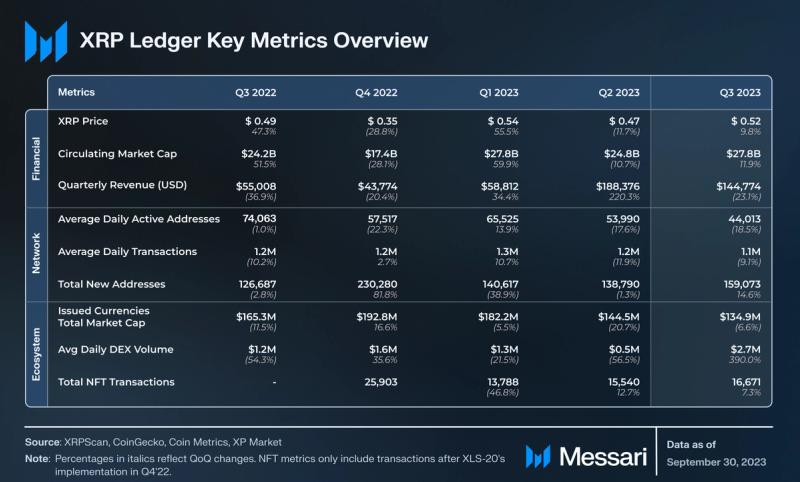
Financial Analysis
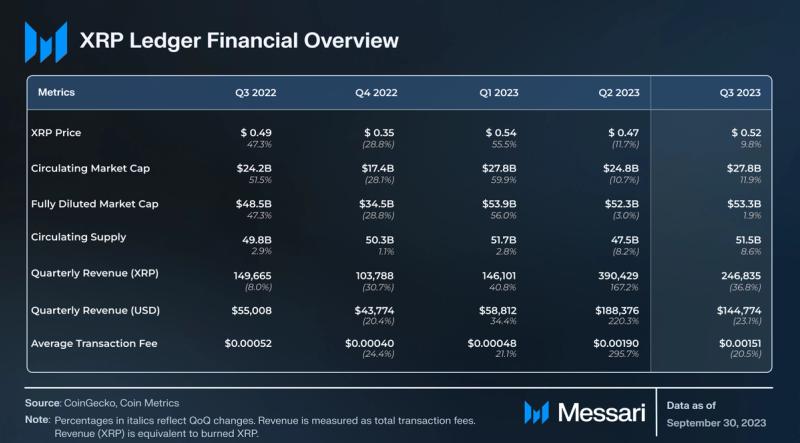
As of Q3’23, the XRPL’s native token, XRP, is the fifth largest cryptocurrency by market capitalization at $27.8 billion. Its circulating market cap increased 11.9% QoQ, erasing the Q2 dip and returning to the same levels as the end of Q1. XRP’s market cap finished the third quarter up 59.9% YTD.
On XRPL, transaction fees are burned, applying deflationary pressure to the total supply of 100 billion XRP. Since the XRP Ledger’s inception, only around 10 million XRP has been burned. Counteracting the burn rate, there is 1 billion XRP that vests to Ripple per month. Any XRP not spent or distributed by Ripple in that month is returned to escrow. This system will continue until the remaining ~48 billion XRP becomes liquid. After all escrowed tokens become liquid, the deflationary pressure from burned fees will be the only variable related to supply.
Unlike many other cryptocurrency networks, the XRPL does not distribute rewards or transaction fees to its validators. In Proof-of-Association (PoA), rather than receiving rewards, validators are mainly incentivized by supporting the decentralization of the network, similar to a full node for Ethereum/Bitcoin rather than a validator/miner. The PoA consensus algorithm relies on trust between nodes, organized through unique node lists (UNLs).

Much of XRP’s Q3 price increase came from a spike in July. Earlier this year, the U.S. Securities and Exchange Commission (SEC) charged Ripple with conducting an unregistered security offering for the XRP token in December 2020. After a long-drawn-out legal battle, on July 13, 2023, the district court ruled in a motion for summary judgment:
- XRP, the token itself, is not an investment contract and thus not in and of itself a security — a unique distinction amongst blockchain assets.
- Ripple’s programmatic sales of XRP did not violate securities laws. These sales were made by Ripple on crypto exchanges where the buyer did not know who they were buying from and could not know they were investing in a common enterprise.
- Ripple’s institutional sales of XRP did violate securities laws. These sales were made directly to institutions where the buyer knew they were investing in Ripple.
XRP’s price spiked over 70% on July 14 and peaked at $0.82 on July 20. The massive revenue spike in June also occurred near news from the SEC case; revenue was ~20x its daily average for three days. Following the court ruling, many CEXs, such as Coinbase and Kraken, relisted XRP. The SEC’s motion to appeal has since been denied.
Network Analysis
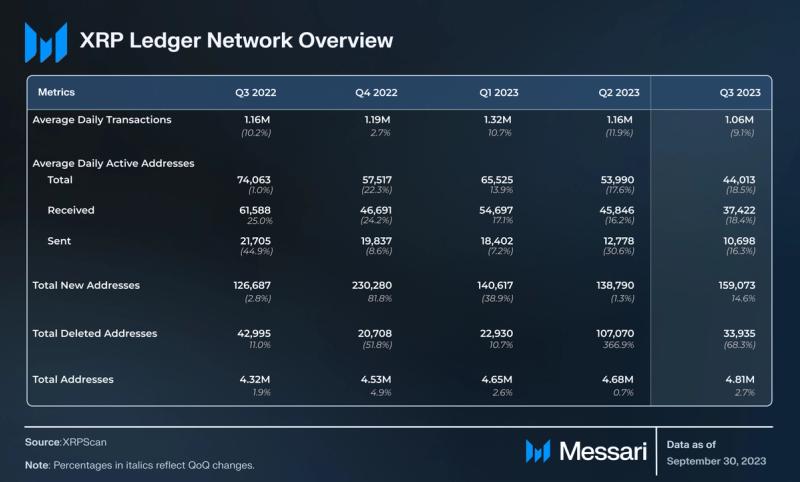
Alongside most other large Layer-1 (L1) networks, XRPL’s network activity metrics fell across the board in Q2. Average daily transactions declined 9.1% QoQ from 1.16 million to 1.06 million. Average daily active addresses took a larger decline, down 18.5% QoQ from 54,000 to 44,000. Average daily values for transactions and all types of active addresses reached yearly lows in Q3.
The net number of accounts increased by ~125,000, driving total accounts up 2.7% to 4.81 million in Q3. New addresses over the quarter increased 14.6% to 159,100. Deleted addresses declined by 68.3% QoQ. This large decrease brought the number of deleted addresses back to a value similar to previous quarters, as Q2 had an unusually large spike. Specifically, AccountDelete transactions were at 50x their daily average from June 15-17 due to activity from the Poloniex exchange.
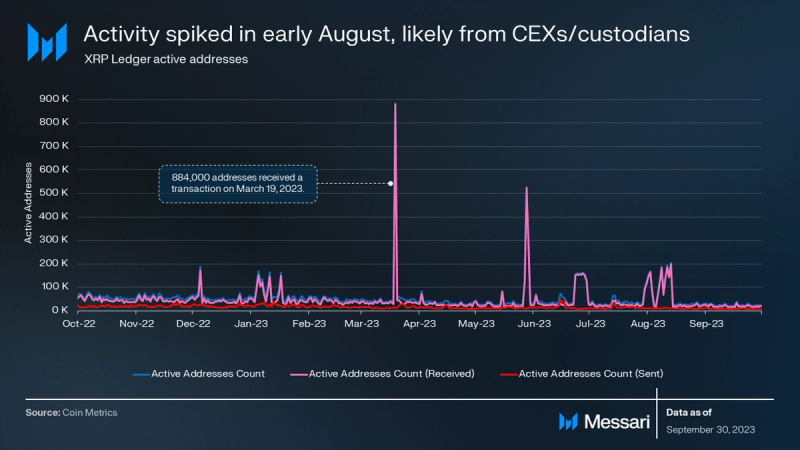
Addresses on the XRPL can contain destination tags, which enable a single address to receive and track XRP deposits for an arbitrary number of users. As a result, the number of daily active addresses is skewed downward, given that one account (e.g., a centralized exchange) could be responsible for a large number of users. It should be noted that a unique address is required for receiving tokens on most other networks, like ETH on Ethereum or BTC on Bitcoin.
The active recipient metric is determined by the number of addresses that receive a transfer or other transaction, which has been the primary factor behind major activity spikes. In contrast, the number of addresses that sent transactions remained relatively stable during Q3. This indicates that the network’s activity surges were generally caused by senders distributing tokens to large groups of previously inactive recipients. The senders were likely exchanges and custody solutions, as they generate many active receiving addresses while only being counted as a single (or few) active sender address. From July 30 to August 13, the XRPL averaged 122,000 daily active addresses (received), which was 3.3x the daily average in Q3.
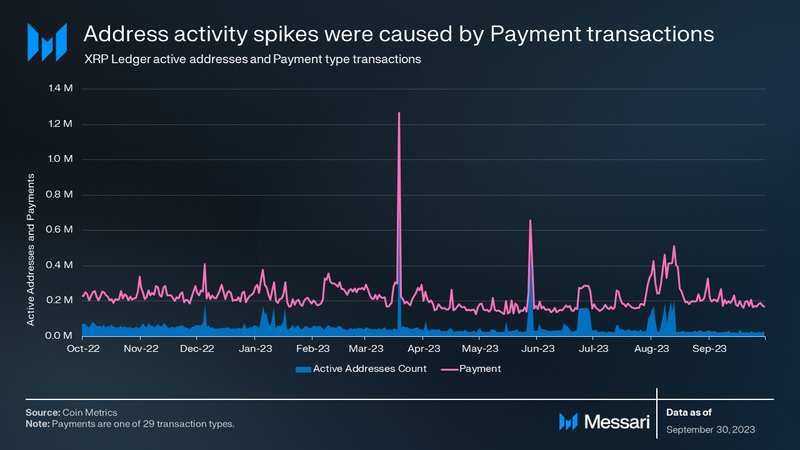
The inequality between the active recipient and sender addresses is largely due to centralized exchanges and custodians using destination tags and sending Payment transactions. Centralized exchanges and custodians mostly use the Payment transaction type for deposits and withdrawals, which has consistently had more receiving addresses than sending addresses. In addition, users typically prefer creating wallets on centralized solutions for easy access to the initial XRP required to create a self-custody wallet. After acquiring their initial XRP, many users withdraw to their self-custody wallets, resulting in fewer active senders and many active receivers.
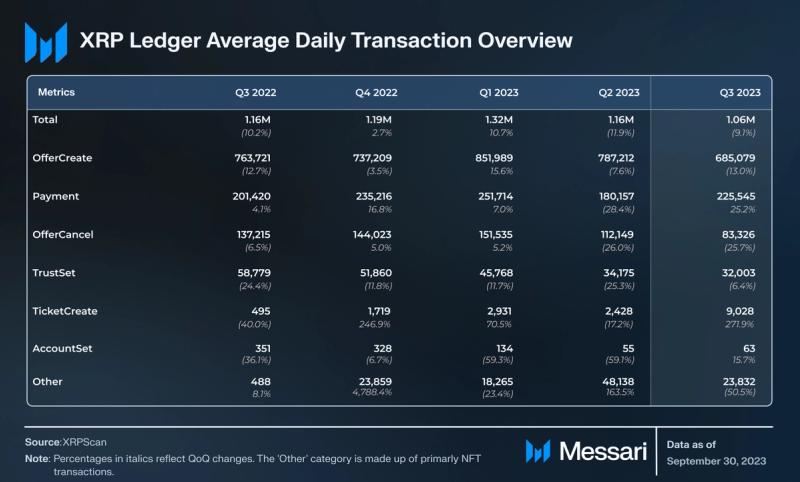
Total daily transactions is a metric made up of 29 different transaction types, such as payments, escrow creations, NFT burns, and account deletion.
OfferCreate, a transaction type that submits an order to exchange cryptoassets, has consistently represented the bulk of transactions. This transaction type only creates an ‘Order’ on the order book and does not necessarily facilitate an exchange unless it completes an existing open Order. OfferCreate initiates a DEX limit order, and Offer objects represent bids/asks on the order book. Offers are consumed to process transactions such as Payments and OfferCancels (triggered manually or by expirations). If an Offer is only partially consumed by a transaction, new Offers are created with the remainder of the original, similar to a UTXO. Offers can be canceled by the OfferCancel transaction. Trust Lines are structures for holding tokens that protect accounts from being sent unwanted tokens, and the TrustSet transaction is used to open or close those Trust Lines.
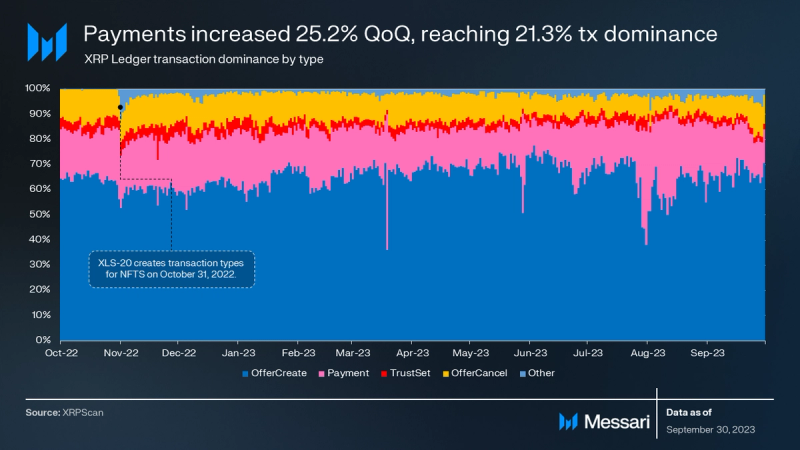
The increase in Payment transactions had the largest impact on shifting overall transaction dominance. Average daily Payments increased 25.2% QoQ to 226,000. Average daily OfferCreates, OfferCancels, and TrustSets — the other three most common transaction types — decreased 13.0%, 25.7%, and 6.4% QoQ, respectively. Overall, total transactions decreased 9.1% QoQ to 1.06 million per day.
The ‘Other’ category of transactions includes functionalities for NFTs, escrows, multisigs, setting signer keys, and more. NFT transaction types were standardized and enabled by XLS-20 in October 2022, resulting in a sudden spike in transaction dominance. These transaction types are covered in depth in the Ecosystem Overview section.
DEX
A built-in central limit order book processes all exchanges on the XRPL for both fungible tokens and NFTs. This decentralized exchange (DEX) comes with the benefit of fewer trust assumptions and consolidated liquidity, rather than the inherent vulnerabilities of smart contracts. The majority of transactions come from the native order book DEX. Although there is only one DEX, there are many marketplaces acting as gateways that facilitate access. Gateways, also known as marketplaces, all share liquidity and provide a viable user interface for the average user.
In addition to the existing order book, an automated market maker (AMM) is being built for the XRPL, as detailed by the XLS-30 standard. The amendment was included in the rippled V1.12.0 release in September. AMMs function through liquidity pools that algorithmically price assets rather than creating offers of preset specifications. Liquidity pools create an opportunity for holders to earn a share of trade fees on their tokens by offering them as liquidity. But, at the same time, they introduce trading risks, such as impermanent loss. New transaction types, such as AMMBid, will be enabled if the proposal passes a future vote to become an amendment.
XRPL GrantsWave 7 launched in Q3 with a focus on DEX innovation. The review begins in October.
Servers
Nodes and validators, known as servers, all run the same client software: rippled. Over 64% of nodes were running the latest version, V1.12.0, as of the end of the quarter. The remaining nods either have yet to vote or have chosen not to update in order to vote against the implemented amendments. As of the end of Q3, the XRPL is supported by 697 nodes and 125 validators. Nodes decreased from 701, and validators increased from 119 in Q2.
XRPL servers participate in federated consensus as part of the XRPL’s Proof-of-Association (PoA) consensus mechanism. Validators do not stake tokens or receive financial rewards. Instead, the system is based on trust between nodes. Each node sets a list of trusted nodes, known as a unique node list (UNL). The UNLModify transaction, which is used to add/remove nodes from a UNL, was called an average of 2.8 times per day in Q3.
Ecosystem Analysis
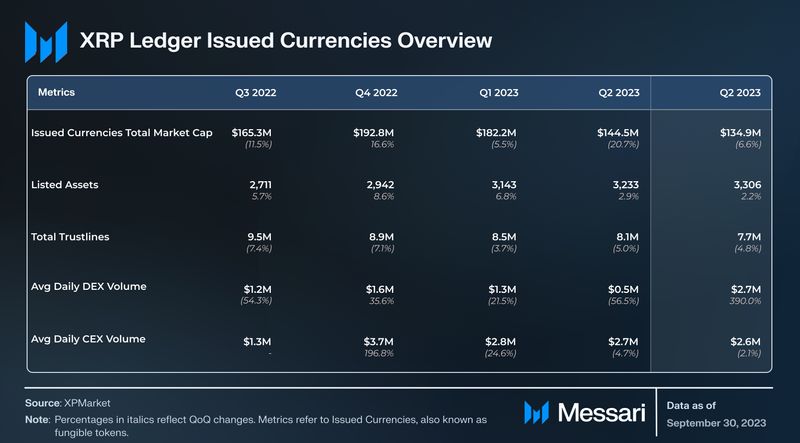
Although the XRPL’s ecosystem hosts many of the same features as programmable settlement networks such as Ethereum, Cardano, and Solana, the XRPL does not yet natively support smart contracts. Arbitrary smart contracts are not enabled on the base layer as a design choice to ensure maximum security and stability. Instead, ecosystem artifacts – such as a DEX and Issued Currencies – are natively built into the protocol. Issued Currencies, also referred to as IOUs, are how the XRPL supports multiple assets. They are onchain representations of arbitrary currencies, commodities, units, etc.
Issued Currencies
The total market cap of fungible tokens, known as Issued Currencies, decreased 6.6% QoQ to $134.9 million. There are over 3,300 listed assets on the XRPL, but the top token, SOLO, accounted for 36% of the total market cap. The top three tokens combined accounted for 50.6% of the total market cap.
The top tokens on the XRPL by market cap were as follows:
- Sologenic (SOLO) had $48.9 million in market cap and 233,000 holders. SOLO is primarily used to pay transaction fees on the Sologenic gateway.
- Gatehub Fifth (ETH) had $10.0 million in market cap and 26,000 holders. Gatehub fifth is a wrapped version of Ether provided by GateHub.
- Coreum (CORE) had $9.3 million in market cap and 56,000 holders. CORE is the native token of the Coreum sidechain, which was also developed by the Sologenic team.
XRPL’s security comes from Trust Lines. They require a lockup of 2 XRP to hold an Issued Currency and wallet reserves, which require a lockup of 10 XRP to create a wallet. These requirements make it expensive to enact a Sybil attack on XRPL metrics, such as the number of holders. For this reason, the number of holders is a reliable metric of a token’s adoption on the XRPL. The metric is especially relevant for fungible tokens, which have much higher supplies than NFTs.
The average daily DEX volume of fungible Issued Currencies increased 290.0% QoQ to $2.7 million — a yearly high. Sologenic is the leading DEX (i.e., the leading gateway to the native DEX) on the XRPL by volume of Issued Currencies exchanged. Other prominent DEXs (gateways) include XPMarket and onXRP.
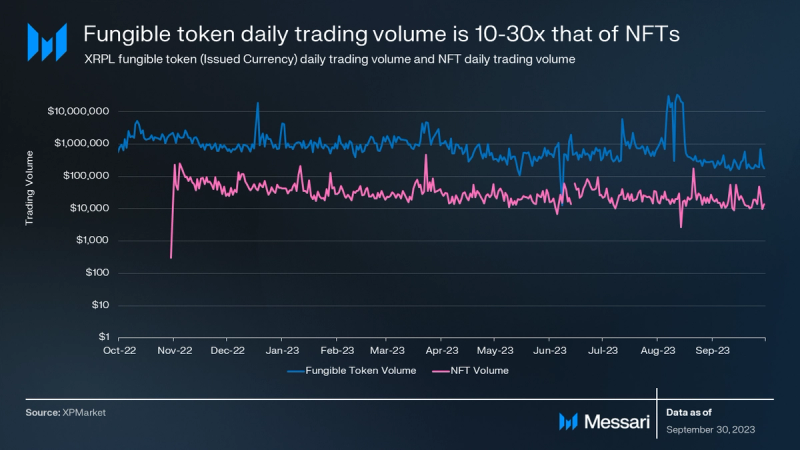
Stablecoins and wrapped tokens are increasingly popular on XRPL, relative to other tokens. ETH, BTC, and USD tokens were four of the top seven tokens by market cap at the end of Q3. Gatehub and Xumm have worked together to offer a total of 14 digital assets on XRPL. The top stablecoins and wrapped tokens (also known as IOUs) on the XRPL are as follows:
- Gatehub ETH: $10.0 million market cap and 26,000 holders
- Bitstamp BTC: $6.9 million market cap and 6,000 holders
- Gatehub USD: $4.5 million market cap and 21,000 holders
- Bitstamp USD: $3.4 million market cap and 28,000 holders
The number of Trust Lines open for a given Issued Currency is generally tightly coupled with the number of holders of said token. The average Issued Currency has around 20-40% more open Trust Lines than holders. Stablecoins and wrapped tokens, on the other hand, typically have 3-10x more Trust Lines than holders. The number of open Trust Lines may be relatively high because users may keep them perpetually open for quick escapes from network-specific volatility. Alternatively, the relatively low number of holders for stablecoins and wrapped tokens could have skewed the percentage differences more than the absolute values would suggest.
Proposal XLS-39d introduced a clawback function to help protect token issuers. This potential amendment would enable token issuers to reclaim issued assets from holders. It was made with regulation in mind, as it gives more control to issuers.
NFTs

On the XRPL, NFTs are built into the core protocol and do not require smart contracts for creation or transfers, like Issued Currencies (also known as native tokens). NFTs were standardized by XLS-20 in October 2022, bringing benefits such as royalties and anti-spam features. These features help users not only avoid unwanted tokens but also stay compliant (specific tokens and smart contracts have been made illegal to interact within specific regions).
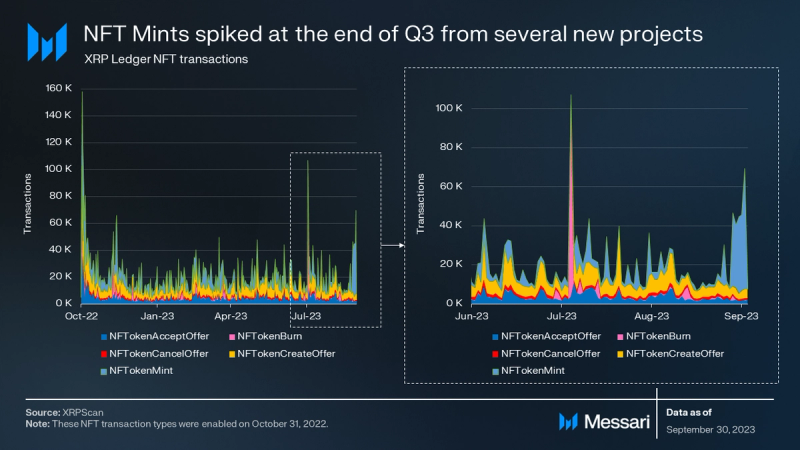
Average daily NFT transactions increased 7.3% QoQ to 16,700. The fastest-growing transaction type was NFTokenBurn, which increased 135.7% QoQ to 1,700. NFTokenMints grew for the second consecutive quarter, up 13.1% in Q3 to 6,300 per day. Other NFT transaction types — NFTokenCreateOffer, NFTokenAcceptOffer, and NFTokenCancelOffer — declined 7.0%, 7.4%, and 2.0% QoQ, respectively.
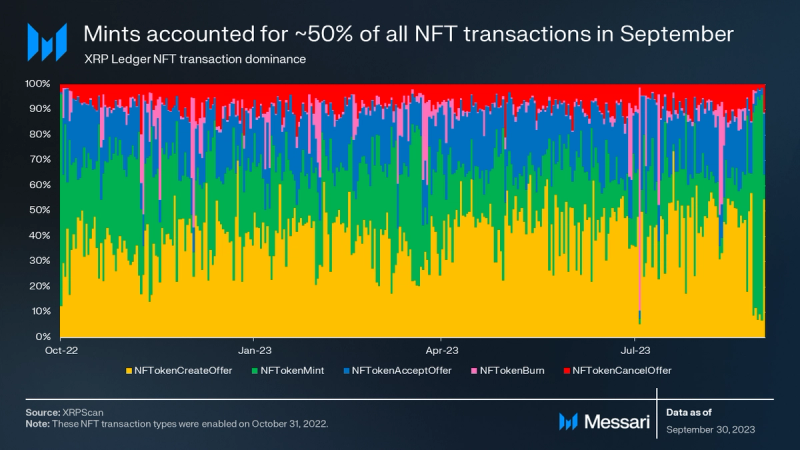
NFTokenMint challenged NFTokenCreateOffer for dominance in Q3. This was due to a large volume in mints in September. The boost in mints was a combined effort by multiple projects, such as identity solution XNS and pfp project XRP Family NFT.
As of the end of Q3, 3.0 million total NFTs have been minted with the XLS-20 standard. XPUNKS remains the all-time leader in NFT sales volume, with 4.4 million XRP ($1.9 million USD) in sales volume.
Sidechains
Multiple sidechains for the XRPL are either in development or have recently launched. The XRPL is staying true to its vision of minimized L1 complexity, offering increased programmability for both general and specific use cases on sidechains.
Coreum
Coreum (CORE) is an enterprise-grade L1 focused on interoperability and scalability. Coreum runs a WASM VM and is secured by a Bonded Proof-of-Stake (BPoS) consensus mechanism. CORE is used for transaction fees, staking, and validator rewards on Coreum. While its market cap was down 22% QoQ from $54 million to $42 million, its circulating supply increased 4% from 516 million to 535 million. The max validator set size increased in Q3 from 40 to 48, and then again to 56. At the end of Q3, however, only 48 validator slots were full. Of those 48, it would only take the top four validators to control over 34% of the voting power.
Coreum was built by the Sologenic team to service user needs that could not be efficiently managed on the XRPL. The initial focus of the network is to provide security tokenization, such as tokenized stocks from the NYSE and synthetic assets. One of Coreum’s upcoming roadmap initiatives is an IBC integration, granting access to all IBC-connected networks such as Cosmos Hub, Ethereum, and BSC. Users can already transfer between Coreum and the XRPL via the noncustodial Sologenic bridge.
EVM Sidechain
Peersyst’s EVM sidechain proposal offers a proof of concept for bringing smart contracts to the XRPL ecosystem. It will grant the XRPL ecosystem access to EVM developers and functionality, with a general-purpose scope. The sidechain is being built on the Cosmos SDK, specifically Ethermint, and connects to the XRPL through the XRPL-EVM bridge. The Devnet is currently live and is creating blocks every ~3.4 seconds using the Comet BFT PoS consensus mechanism, a variant of Tendermint.
The latest version of Peersyst’s EVM sidechain was deployed on Devnet V2 in Q2 2023. Dapps such as identity protocol XRPDomains have been deployed on the testnet. Notable additions to the latest version include:
- Support for XRP, IOU, and ERC-20 token transfers via the bridge
- Proof-of-Authority consensus
- Smart contract verification on the block explorer
Additionally, this EVM sidechain is connected to the XRPL using the same bridge design proposed in the cross-chain bridges (XLS-38d) specification. XLS-38d was audited by Bishop Fox in Q3.
The bridging of XRP, IOUs, and ERC-20s on this sidechain was implemented following the specifications of the XLS-38d bridging standard. XLS-38d was first proposed by Ripple developers in February 2023 for a cross-chain bridge between the XRPL mainnet and any sidechain. Bridges built by this standard will lock tokens on the XRPL to first mint a wrapped version on the sidechain and then later burn the wrapped tokens to unlock the original assets on the XRPL. A new node type called a “witness server” will communicate between chains. Witness servers together operate the door account connecting the XRPL mainnet.
Root Network
The Root Network sidechain is a blockchain-based NFT system with a focus on UX and metaverse, run by Futureverse. The Root Network is live in alpha, along with its bridge to XRPL and Ethereum. The Root Network uses XRP as the default gas token, was built from a fork of Substrate, and has EVM support for smart contracts. The Root Network uses a delegated-Proof-of-Stake (dPoS) consensus mechanism (uses the ROOT token). The protocol’s roadmap items are aligned with the XRPL, as they seek to integrate the XLS-20 NFT standard and source liquidity from the XRPL DEX. Root Network also plans to offer users social recovery, management of assets, increased wallet flexibility, and a familiar Web2 experience through the account abstraction solution FuturePass.
Hooks
Hooks is a feature to include smart contract functionality in XRPL transactions. While Hooks are not Turing complete and do not enable arbitrary logic, they do allow conditions and triggers to be attached to transactions — similar to scripts on UTXO chains like Bitcoin and Cardano (pre-Alonzo).
Hooks went live on XRPL Labs’ public testnet in Q2. In Q3, the Xahau Launch Alliance (comprised of Evernode, XRPL Labs, Alloy Networks, and Gatehub) released a whitepaper for a sidechain called Xahau Network. Xahau, powered by Hooks, will function similarly to an L2 where developers can build dapps in general-purpose languages such as C and JavaScript. Evernode was one of the recipients of XRPL Grants Wave 5. Xahau plans to add a native token, XAH, with its own tokenomics.
Hooks enable several programmed features. These include scheduled payments, distributing a set percentage of funds to a creator for royalties, or imposing limits/restrictions on transactions for both volumes and counterparties.
Enterprise Solutions
Ripple is one of the leading companies developing technologies to leverage the XRPL for institutional and government use cases. The company is focused on utilizing XRP and the XRPL to drive its On-Demand Liquidity service and CBDC initiatives.
The XRPL continues to be at the forefront of CBDC explorations by various governments. The new Ripple CBDC platform is based on the same blockchain technology used by the XRPL. Ripple is working with more than 20 countries on CBDC plans and hopes to leverage the XRPL to realize those visions. Most recently, the Central Bank of Colombia began working with Peersyst and Ripple toward a CBDC.
In Q3, Ripple announced the six finalists for the Ripple CBDC Innovative program that kicked off in Q2. Judges will look to distribute $200,000 in prizes to participants building CBDC-based products. This is the program’s second year.
Closing Summary
The multi-year lawsuit between the SEC and Ripple appears to have finally yielded substantive results, confirming that XRP is not, in itself, a security. Following this positive news, XRP’s price spiked over 70% in a single day, and XRPL’s DEX volume increased nearly 400% QoQ.
New developments, both on the base layer and on other networks in the greater ecosystem, aim to create additional use cases for the XRPL. On the XRPL mainnet, the enshrined automated market maker was included in node software rippled V1.12.0. It will enhance the liquidity of tokenized assets and enable liquidity provision opportunities for retail users. Another feature, Clawback, enables XRPL asset issuers to claw back user funds to meet regulatory requirements. The Xahau Network sidechain aims to leverage Hooks to bring more advanced computation to the ecosystem.
















